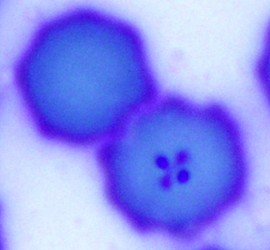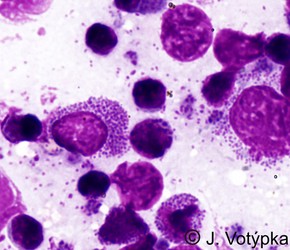Theileriidae
Theileria
Jan VotýpkaIntroduction
Family Theileriidae du Toit, 1918
Only one genus is accommodated within this family.
Theileria Bettencourt, Franca and Borges, 1907
Type species Theileria parva (Theiler, 1904) Bettencourt, Franca and Borges, 1907
Theileria, the causative agent of theileriosis, are economically important parasites transmitted by ixodid ticks. They infect wild and domestic mammals, but mainly ruminants. In the mammalian host, leukocytes and erythrocytes are the infected cells. In the arthropod vector (tick) theileriids develop in gut epithelial cells and salivary glands. Members of the family are relatively small, round, ovoid, irregular, or bacilliform parasites. When compared with Babesiidae, their apical complex is much more reduced and includes only rhoptries. Polar ring, conoid, micronemes, and sub- pellicular tubules are absent. The micropore is present only in the erythrocytic stage. Some stages occur in vertebrate erythrocytes and others in lymphocytes, histiocytes, erythroblasts, etc., where schizogony takes place. Merogony is followed by the invasion of meronts into erythrocytes, where they may or may not reproduce. In the former case they divide into two or four daughter cells.
Characteristics
After injection into the vertebrate host, sporozoites enter the T and B lymphocytes or macrophages by a process significantly different from the invasion process known for the other apicomplexans. Sporozoites as well as merozoites enter into host cells (lymphocytes and erythrocytes) by zippering in from any orientation. Importantly, the invasion does not require re-orientation of the parasite’s apical end toward the host cell membrane, with the internalization being much slower than in the other apicomplexans. The completely surrounded and internalized sporozoites and merozoites release the content of their secretory organelles (rhoptries and granular bodies), which apparently allows them to escape from the enclosing parasitophorous vacuole into the host cytoplasm. Once established in the host cytoplasm, the parasite grows and differentiates into a multinucleate schizont and by a remarkable, as yet largely unknown mechanism, transforms infected host lymphocytes into immortal cells (blastic transformation), which leads to their clonal expansion.
Leucocytes filled with schizonts are called the Koch’s bodies. Merozoites released from them invade erythrocytes, where usually another round of division occurs, producing a generation of merozoites, which in turn infect new erythrocytes. These processes are particularly pronouned in species with limited or missing intralymphocytic multiplication. Multiplication in erythrocytes results in four (rarely two) merozoites forming characteristic tetrads (the Maltese cross), yet some species (T. parva) do not multiply in the red blood cells, their multiple rounds of asexual division being confined only to lymphocytes.
Gamogony occurs in the vector’s intestine, where ray bodies fuse to produce a motile zygote. This stage invades epithelial cells of the gut, where it transforms into a single motile kinete similar to the haemosporidian ookinetes, and remains there during the development of the tick (trans-stadial transmission). However, unlike in Babesia, the kinete does not multiply and ceases to develop further in the gut, but transverses the gut wall and via the coelom and hemolymph reaches and consequently penetrates the cells in salivary glands, where sporogony takes place. Feeding of the tick initiates rapid sporozoite development and in the glandular epithelium parasites rapidly multiply and produce an enormous number of sporozoites (up to 100 000 per each kinete) that escape into the salivary ducts.
The genus Theileria (the only genus of the family Theileriidae) is the causative agents of a variety of disease syndromes in domestic and wild ruminants, and is collectively responsible for economic losses amounting to hundreds of millions of dollars annually in Sub-Saharan Africa and Asia. Economically important Theileria species that infect cattle are Theileria annulata, T. buffeli, T. mutans, T. orientalis, T. parva, T. sergenti, T. velifera, and T. tarurotragi. Species from small ruminants (see below) and horses (Theileria equi – formerly Babesia equi) are transmitted by ixodid ticks of the genera Rhipicephalus, Amblyomma, Hyalomma, and Haemaphysalis. About 40 Theileria species infect mainly ruminants in Africa and Asia, but also Australia’s marsupials and other hosts. The two most important species (both infecting cattle) are T. parva, which causes the East Coast fever in Africa, and T. annulata, the causative agent of the tropical or Mediterranean theileriosis. Species such as T. ovis are pathogenic to sheep and to other small ruminants, other ovine and caprine theilerioses are caused by Theileria lestoquardi, T. separata, T. recondite, and Theileria sp. ‘China’.
Discussion of Phylogenetic Relationships
The classical difference between the genera Theileria and Babesia is the absence of the extra-erythrocytic asexual multiplication (schizogony) in Babesia, while schizogony in Theileria occurs in the lymph nodes and erythrocytes rather than in the erythrocytes alone. Another typical feature is the parasite cycle in the vector tick, which includes transovarial transmission in Babesia but only transstadial transmission in Theileria, and also, the multiplication in the red cell results in two daughter cells (merozoites) in Babesia, while four merozoites (Maltese cross) in Theileria.
Despite such a clear distinction, systematic affiliations of several species of piroplasms, even those with economic impact, remain unresolved. Small piroplasms of equines are still affiliated with Babesia, although they in fact belong to the genus Theileria. Two species of piroplasms are described in equids, Babesia caballi and Babesia equi; the latter has been transferred to the genus Theileria based on the characteristics of the life cycle and phylogenetic analysis. Even more complicated is the situation with Babesia microti. It has schizogony in lymphocytes and its development and transmission in ticks are more similar to Theileria. On the other hand, molecular evidence indicates that these parasites differ both from Theileria and Babesia. As in other apicomplexan groups, molecular tools are becoming increasingly important for phylogeny reconstruction within the order Piroplasmida.
Title Illustrations

| Scientific Name | Theileria sp. in blood of donkey |
|---|---|
| Location | Kenya |
| Image Use |
 This media file is licensed under the Creative Commons Attribution-NonCommercial License - Version 3.0. This media file is licensed under the Creative Commons Attribution-NonCommercial License - Version 3.0.
|
| Copyright | © Moneeb Qablan |
| Scientific Name | Theileria sp. |
|---|---|
| Location | Leucocytes filled with schizonts - Kochs bodies |
| Image Use |
 This media file is licensed under the Creative Commons Attribution-NonCommercial License - Version 3.0. This media file is licensed under the Creative Commons Attribution-NonCommercial License - Version 3.0.
|
| Copyright |
© 2008 Jan Votępka

|
About This Page
This page is being developed as part of the Tree of Life Web Project Protist Diversity Workshop, co-sponsored by the Canadian Institute for Advanced Research (CIFAR) program in Integrated Microbial Biodiversity and the Tula Foundation.
Jan Votýpka

Department of Parasitology, Charles University
Correspondence regarding this page should be directed to Jan Votępka at
Page copyright © 2011 Jan Votępka
 Page: Tree of Life
Theileriidae. Theileria.
Authored by
Jan Votępka.
The TEXT of this page is licensed under the
Creative Commons Attribution-NonCommercial License - Version 3.0. Note that images and other media
featured on this page are each governed by their own license, and they may or may not be available
for reuse. Click on an image or a media link to access the media data window, which provides the
relevant licensing information. For the general terms and conditions of ToL material reuse and
redistribution, please see the Tree of Life Copyright
Policies.
Page: Tree of Life
Theileriidae. Theileria.
Authored by
Jan Votępka.
The TEXT of this page is licensed under the
Creative Commons Attribution-NonCommercial License - Version 3.0. Note that images and other media
featured on this page are each governed by their own license, and they may or may not be available
for reuse. Click on an image or a media link to access the media data window, which provides the
relevant licensing information. For the general terms and conditions of ToL material reuse and
redistribution, please see the Tree of Life Copyright
Policies.
- First online 18 May 2011
- Content changed 18 May 2011
Citing this page:
Votýpka, Jan. 2011. Theileriidae. Theileria. Version 18 May 2011 (under construction). http://tolweb.org/Theileria/68078/2011.05.18 in The Tree of Life Web Project, http://tolweb.org/










 Go to quick links
Go to quick search
Go to navigation for this section of the ToL site
Go to detailed links for the ToL site
Go to quick links
Go to quick search
Go to navigation for this section of the ToL site
Go to detailed links for the ToL site